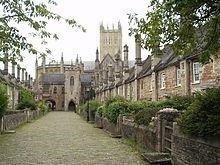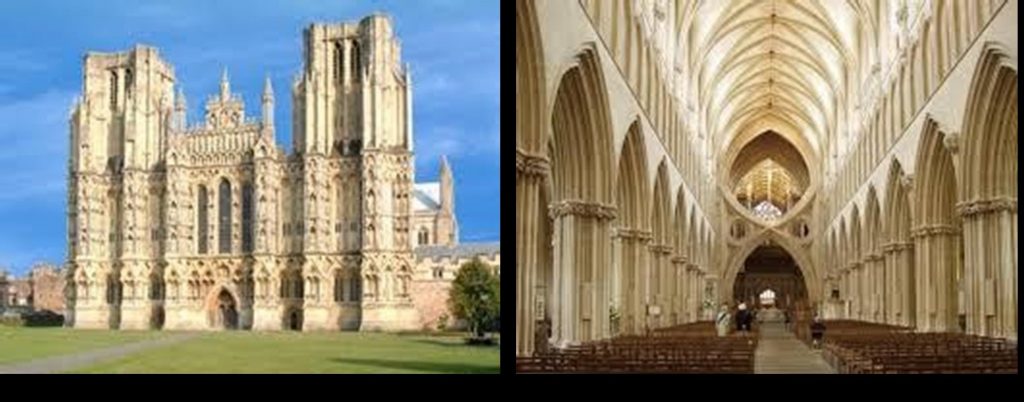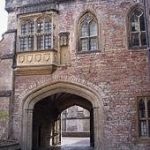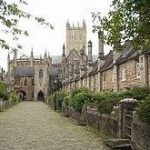 Number 551 FEBRUARY 2017 Edited by Andy Simpson
Number 551 FEBRUARY 2017 Edited by Andy Simpson
HADAS DIARY – LECTURE PROGRAMME 2017
Tuesday 14th February 2017; London Ceramics at the time of the Great Fire, by Jacqui Pearce
Tuesday 14th March 2017; Bugging the Nazis in WW2; Trent Park’s Secret History, by Helen Fry
Tuesday 11th April 2017; To Be Confirmed
Tuesday 9th May 2017; The Cheapside Hoard, by Hazel Forsyth
Tuesday 13th June 2017; ANNUAL GENERAL MEETING
Tuesday 10th October 2017; The Curtain Playhouse Excavations, by Heather
Knight, MOLA
Tuesday 14th November 2017; The Battle of Barnet Project, by Sam Wilson
Lectures are held at Avenue House, 17 East End Road, Finchley, N3 3QE, and start promptly at 8 pm, with coffee/tea and biscuits afterwards. Non-members: £1. Buses 82, 125, 143, 326 & 460 pass nearby and Finchley Central station (Northern Line), is a 5-10 minute walk away.
Post-Excavation Work – Medieval Cricklewood! Andy Simpson
As ever, Sunday Mornings at Avenue (Stephens) House continue in the usual vein with the ‘usual suspects’. Good work is again being done on the Clitterhouse Farm 2016 (site code CTH 16) excavation finds analysis, with all finds now washed and marked. The bulk finds sheets have also been completed. More medieval pottery has been identified from across the site, to supplement the three sherds of southHertfordshire type grey Ware (MOLA fabric code SHER, 1170-1350) found in 2015, including a body sherd of SHER and two body sherds of early south-Hertfordshire type coarse ware (ESHER) dated 1050-1200 – our first potential Conquest period pottery from the site.
Contemporary with these is a single small body sherd of early medieval coarse sand- tempered ware (EMCS, 1050-1200)
There is also a single body sherd of late medieval Hertfordshire glazed ware (LMHG, 1340- 1450). All of the 2016 medieval pottery is from disturbed residual contexts, unlike the SHER found in 2015 in a presumed primary ditch fill.
This is an exciting development pushing back the known chronology of the site.
Footpads Talk: A Reflection on Finchley Common robberies. Simon Williams
Simon adds some more local details following on from the report on the talk on footpads in South London by Margarette Lincoln in the January newsletter.
At its peak, Finchley Common was 5.0 km2; by enclosure (1816) it was reduced to 3.6km2; of mostly woodland—comprising Copetts Wood, Coldfall Wood & The Glebelands; it sprawled from East Finchley to Barnet.
The famous clown ‘Joey’ Joseph Grimaldi 1778-1837 (who single-handedly revolutionised the clown from the Shakespearean rustic buffoon to the version we recognise today: inventing face-paint, bright clothes, the pantomime catchphrase, combined with it’s star-act/pop personality- association, his one-time ‘Hot Codlins’ fame) was robbed on Finchley Common c.1800; he lived near the present Finchley Memorial Hospital. The Earl of Minto stated to his wife that he would not, “trust my throat on Finchley Common in the dark”. Edmund Burke MP was also a victim in 1774. Villains associated with the Common include Jack Shepard, Dick Turpin & the “Wicked Lady’s” lover (he was caught there).
Less famous were ‘Everett & Williams’ who went as far as to draw up a legally witnessed contract that they would split their plunder after a year’s work in 1725.Gibbets were in use here from at least the 1670’s, another was at Tally-Ho Corner.
A combination of the Enclosure Act, paper money which in 1797 was easily traceable (presumably because there wasn’t much in personal circulation?), together with the opening of the first bank in 1692 meant that travellers to London no longer carried huge amounts of gold on them.
The Bow Street Horse Patrol policed from Highgate to Barnet between 1805-51; was it finally stopped due to reduced traffic?- in the advent of the railway boom?
These possibly conspired to put the robbers out of business? As one looks at the bleak unforgiving municipal streets of Barnet today, albeit no Sylvan Idyll, we are all probably better- off?!
Bradford on Avon – Day 4 Jim Nelhams
Thursday started with a stop in the market town of Frome, from whence we moved on to Wells. It seemed that few of our group had visited Frome before, and although a number had been to Wells, few had visited the Bishop’s Palace. We started in Frome at the parish church on a hill above the town centre before making our way down Cheap Street to the Museum, yet another important organisation run entirely by volunteers.
St John the Baptist Church, Frome Dudley Miles
The original church was built in 685 by Aldhelm, Bishop of Sherborne and a leading Anglo-Saxon scholar. Virtually nothing survives of his church, and it was remodelled on several occasions, most notably in the thirteenth century, and in the Victorian period, when it had fallen into a derelict state and much of it was rebuilt by the controversial Anglo-Catholic priest, W. J. E. Bennett.
The Lady Chapel dates back to Norman times and has a Saxon window, as well as ten windows by the leading Victorian stained glass designer, Charles Kempe. Another survival is St Nicholas Chapel, now the baptistery, which dates to 1408 and has a fine thirteenth-century font.
Several of us were fascinated by two Saxon stones. The upper one, which dates to the eighth century, is part of a vertical shaft of a cross, while the lower one, which is ninth century, is a carving of an animal. Sadly, there is no evidence that the stones were part of the Anglo-Saxon church.
A unique feature is the nineteenth-century Via Crucis or Way of the Cross, a set of statues illustrating Christ’s road to Calvary on a processional way up the steps to the church. Unfortunately, the gate from the street to the processional way is now locked.
Cheap Street, Frome Beverley Perkins
Down the hill from the St John’s Church lies Cheap Street, the original shopping street of Frome (from the Saxon name for barter – ceap). Frome was granted a charter for a market in 1239 and the street itself dates from that period. However, the existing buildings were mainly constructed in the 1500s and, following a fire, in the 1830s. Although some half-timbered buildings with jettied upper storeys remain, the origins of most are disguised by more recent frontages and by modern shop windows at ground floor level. No. 11 Cheap Street, a Tudor house with overhanging jetties and massive beams carved with rosettes, is the oldest house in Frome. A narrow rivulet runs down the centre of the cobbled street – picturesque, but a hazard for walkers!
Frome is known for its Cockey lamps, unique to Frome and made in art nouveau style by local company Edward Cockey & Sons. Originally made for gas, they were later converted to electricity. One of these lamps spans Cheap Street in an elegant arch. For more information see https://fromemuseum.wordpress.com/collection/metalworking/cockey and for photographs see www.frometowncouncil.gov.uk/wp-content/uploads/2016/06/FromeCockey-Lamps-2016.pdf.
Frome Museum Claudette Carlton
Frome Museum is situated in a Georgian house. At present the Museum is located on the ground floor, but there are plans to extend to the upper floor of the building next year.
There is a very elegant staircase connecting the floors of the house.
The group was welcomed by Emma and David Robinson, members of HADAS, who, although resident in Colindale, spend a lot of their time in Frome. Emma is Chair of the Trustees of the Museum. Tea, coffee and very good cake were provided for the group, for which many thanks.
There is a fascinating cabinet of curiosities in the museum, pictorial records of the casting of bronzes in the Singer foundry in Frome, including that of Boudicca/ Boudicia, which now stands on the Thames Embankment and of Sheppards Mills, a textiles mill sited in Spring Gardens Frome. In its heyday children as young as 7 years worked there, 6am to 7pm, Monday to Friday, and up to 2pm on Saturday. The mill closed in 1878.
There was also a display of the record of one local man’s service in the Great War, his medals and other memorabilia; and another about Siegfried Sassoon, some of his poems, and a brief account of his life.
Many thanks to HADAS for allowing me to do this trip, and to the group for their good company.
Bishop’s Palace, Wells Ken Sutherland Thomas
On arrival in Wells, we were presented with a wealth of historic sites to visit including the Bishop’s Palace and the Cathedral.
On entering the Palace grounds and skirting the appealing coffee shop, I planned firstly to explore the gardens and to enjoy the views from the walkway on the ramparts. The Palace has been the home of the Bishops of Bath and Wells for over 800 years.
The gardens are about 14 acres in extent and include a number of pools (where the original wells were in times past the fresh water source for the local population).
Some of the pools afford wonderful reflections of Wells Cathedral.
I did not have time to explore the Arboretum which is also part of the grounds. With the time limited, I joined a group of visitors for a tour of the Palace buildings open to the public.
The Palace partly dates from the 13th century and work commenced on it when Bishop Joselin Trotman received a Royal licence to build a residence and Deer Park on land to the south of Wells Cathedral, St Andrews.
Our guide took us into the vaulted undercroft and then up an impressive staircase to what in past times would be the rooms where the Bishop ate and slept as well as entertained. We viewed the large gallery with many paintings of past Bishops as well as other artefacts.
Exiting the Palace, time allowed for a short visit to the ruins of the Great Hall. Built in 1290 for Bishop Burnell, the remains are the most impressive example of a Medieval open hall. It was built in Early English Decorative style. The remaining large windows frame beautiful views of the Cathedral.
Leaving the Palace grounds, I briefly joined many other visitors hoping to see the Wells Swans on the moat around the Palace. The swans are renowned for ringing a bell when it is feeding time.
Wells Cathedral Frances Radford
 Wells is one of the most memorable of English Cathedrals due externally to the grandeur of the West Walls and internally to the unique scissor like structure which dominates the view from the nave.
Wells is one of the most memorable of English Cathedrals due externally to the grandeur of the West Walls and internally to the unique scissor like structure which dominates the view from the nave.
The façade of the West Front presents as a giant screen intended for a display of statuary. The great breadth of the front is emphasised by two string courses which define three horizontal zones countered by the verticals of the buttresses.
The lowest section contained scenes from both Old and New Testaments. Above this, statues of knights and ladies, kings and queens, bishops and saints and above them a row of the twelve disciples. At the top, centrally placed, a figure of Christ in Majesty. St Andrew, the patron saint of the cathedral is represented.
Many figures were damaged or disappeared later, but in their original state were, no doubt, intended to educate and impress the public, underlining the importance of the Cathedral and the Christian religion. It must have been particularly impressive when the west front was painted in bright colours or red, blue and green, providing a dramatic background for religious processions such as on Palm Sunday.
The first thing that strikes you as you arrive in the nave is the extraordinary scissorlike structure at the entrance to the quire, built 1338. The pale colour of the stonework plus the unusual shape gives, at first glance, a modern feel to the building. Its pointed arch fits well with the Gothic arches in the nave, making it part of the whole. The scissor arches were erected on three sides of the crossing in order to support the tower, as it had begun to crack and lean. One cannot help but be amazed at the ingenuity and skill of these early builders – (without all our modern technology).
The great Jesse Window above the high altar shows Christ’s family tree from the beginning with Jesse, the father of King David. In the Lady Chapel, there are more windows of note, four out of five of which are completely composed of fragments of ancient glass rescued after the destruction the Cathedral suffered as the result of the Civil War (1662-7) and the Monmouth Rebellion (1685). These jumbled fragments assembled together have made very beautiful windows.
The Lady Chapel is an elongated octagon but open westwards so is not separate from the body of the Cathedral. The floor has an intricate pattern of Victorian style tiles in black, cream and terracotta, while above, the ribs of the vault become a central star, painted as a copy of the original decoration.
Outside this chapel is a tall brass lectern inscribed to Dr Robert Creyghton who returned after fifteen years’ exile. “His Sovereign Lord King Charles II made him Dean of Wells in 1660” and gave the lectern to the Cathedral.
The misericords, beautifully carved, and the carvings on the capitals and corbel stones give a picture of life at the workers’ level; man with toothache, man removing a thorn from his foot, trout stealers being beaten, and a sleeping cat: also the headstone said to be of master craftsman Adam Lock.
Alas, due to shortage of time, many other treasures were missed including the Chapter House.
P.S. Quote from The Cathedrals of England by Alec Clifton-Taylor (architectural historian and critic) re scissor structure…
“Although their mason-craft is much more agreeable than modern concrete, in their audacity, even starkness, they carry analogies with certain contemporary structures, especially bridges, in that material.
Accordingly, there are those who wax enthusiastic about the strainer arches of Wells; but the plain truth can only be that in a building so exquisitely detailed, so abounding in subtleties, they are a grotesque intrusion” What do you think?
Vicars’ Close Katie McGrath
Vicars Choral, the men who sing in the choir at Wells Cathedral, have been established since 1140. In 1348 they were incorporated as a College of Vicars when the dining hall above the archway leading into the close came into use. This allowed them to transact their business and eat communally. The houses were completed by 1363. Originally there were 42 small houses forming a quadrangle with a chapel for the vicars at the far end, above which was their Library. In 1466 further alterations were made and the chimneys were raised and crowned with tall decorative octagonal stacks. Round about this time a Chain Bridge was built to link Vicars’ Hall with the Cathedral, and gardens were introduced. Following the Reformation in the 15th century the number of vicars was reduced and they were allowed to marry, so the houses were put together to form larger dwellings and Vicars’ Close took on its present appearance. Today, together with the choristers, the Vicars Choral sing services every day in term time. They still live in the Close, as do other members of the Cathedral foundation, including the Organist and Master of the Choristers. Altogether Vicars’ Close is an exceptional group of buildings and forms an important part of the whole Cathedral complex.
It is claimed to be the oldest purely residential street with original buildings surviving intact in Europe.
January Lecture Report – My Uncle, the Battle of Britain VC
by James Nicolson Lecture Report by Andy Simpson
A small group of HADAS members and visitors enjoyed this most informative talk.
The first-born son of the Nicolson family is traditionally called James. Our speaker continues the tradition with the eldest of his two sons. However, just to confuse matters, the subject of the talk – Wing Commander Eric James Brindley Nicolson VC DFC (29 April 1917 – 2 May 1945) was christened Eric, called Nick in the RAF, and
Bill by his family! Of some 150,000 aircrew on wartime ops in the RAF (of whom 55,000 died in Bomber Command alone), just 26 were awarded Britain’s highest military gallantry award, the Victoria Cross (VC), with Nicolson the only Fighter Command Recipient.
Nicolson was born at 38 Crediton Hill, Hampstead, living there until aged seven when the family moved to Shoreham, West Sussex. Always keen on joining the RAF, an initial attempt was unsuccessful so he joined a local engineering firm and became a keen amateur cricketer. Being 6ft 3ins tall he was a good bowler. He joined the RAF in October 1936, being posted to RAF Church Fenton in Yorkshire, flying Gloster Gladiator biplane Fighters with No. 72 Squadron. As Section Leader of three, his particular aircraft was serial number K6140. He became an accomplished display pilot, even broadcasting to the crowd during the 1939 air display. He and his fellow squadron members led a typically high-spirited off-duty life, racing their MG sports cars in reverse around the airfield!
He was careful however to give his ground crew five Players cigarettes each every Friday morning. The then standard battle formation of a ‘vic’ of three aircraft was too rigid. The two wingmen were meant to closely follow the leader and fire their four Browning machine guns each on his lead, concentrating so hard on keeping formation and not colliding with one another that they had little time to detect incoming attacking fighters. The Germans, with their much looser formations based on a ‘rotte’ (pair), even coined the term ‘row of idiots’ for this formation.
The 72 Squadron aircraft swapped all-over silver for hastily-applied camouflage at the time of the Munich Crisis in 1938. A telling group photo of Nicolson and his six Squadron chums at this time led to the recounting of the final toll – two badly burnt, two killed and two otherwise wounded. At this time he also met a farmers’ daughter from Tadcaster –Muriel, 13 years his senior. She was reluctant at first due to the age gap, but in July 1939 they commenced a happy marriage.
The VC was presented during an informal chat with the King at Buckingham Palace, his wife being allowed to attend also. Nicolson felt awkward and was ordered to wear his medal ribbon, which he usually hid by wearing an overcoat.
Fully recovered by September 1941 and keen to get back to flying, Nicolson was posted to India in 1942. Between August 1943 and August 1944 he was a Squadron Leader and C.O. of No 27 Squadron, flying Bristol Beaufighters over Burma, being very successfully teamed with his navigator and gaining the DFC and an old-beforehis-time look in photographs. During this time he was awarded the Distinguished Flying Cross and was involved with two squadron mascots – young bear cubs who rather outgrew their welcome. One was shot and the other eventually parachuted out over the jungle from a Dakota after he persistently returned to base!
As a Wing Commander, he was killed on 2 May 1945 when a RAF B-24 Liberator
‘R-Robert’ from No. 355 Squadron, in which he was flying as an observer for a bombing raid on Rangoon, caught fire and crashed into the Bay of Bengal after two engines failed.
Although he was one of four of the crew of ten who made it into a dinghy after ditching and were eventually found by a Catalina flying boat, he sadly drowned and his body was not recovered. He is commemorated on the Singapore Memorial.
Muriel Nicolson received the telegram informing her of his death on 8 May 1945 – VE Day. He left an estate of just £212, leaving Muriel in financial hardship; their son won a scholarship to Rugby School. She never remarried, living to over 100, and eventually sold his medals for £110,000 in 1983 – then a world record. They are now held by the RAF Museum at Hendon. The RAF Museum also holds Spitfire Mk 1 K9942 (at RAFM Cosford) flown by Nicolson with 72 Squadron in 1939-40.
An RAF VC-10 transport carried his name in the 1970s/80s and a Battle of Britain Memorial flight Hurricane carried the markings of his Hurricane for a while, along with a RAF Eurofighter Typhoon fighter for the 2016 display season.
Other Societies’ Events Eric Morgan
Thursday 16th February, 7.30pm Camden History Society Burgh House, New End Sq, NW3 1LT. Played in Camden – The Sporting & Recreational Heritage of a Borough at Play. Talk by Simon Inglis. Visitors £1.
Friday 17th February, 7.30pm; Wembley History Society English Martyrs Hall
Chalk Hill Road Wembley HA9 9EW (Top of Blackbird Hill, Adj. to Church) A Tour of Elizabethan London Talk by Nick Dobson Visitors £3. Refreshments available.
Thursday 23rd February 2.30pm Finchley Society Drawing Room, Avenue House
(Stephens House) 17 East End Road N3 3QE- Investigating our Local Community – Talk by Archer Academy Year 7 Students and Air Pollution Survey of North Finchley Talk by Chris Church Non-members £2 . Refreshments available.
Thursday 2 March 8pm Pinner Local History Society Village Hall, Chapel Lane Car Park, Pinner. Pinner’s Grand Houses & the People who Lived in Them – Presentation by Research Group – New Research by Society Members . Visitors £2.
Wednesday 8th March , 2.30pm Mill Hill Historical Society Trinity Church, The Broadway, NW7. Hidden Rivers at Stanmore Marshes Vicki D’Souza & AGM.
Wednesday 8th March, 7.45pm Hornsey Historical Society Union Church Hall, Corner Ferme Park Road /Weston Park N8 9PX Tottenham’s Forgotten Houses Talk by Val Crosby Visitors £2 Refreshments, Sales & Info from 730pm.
Monday 13th March, 3pm Barnet Museum & Local History Society Church House, Wood St, Barnet (Opp. Museum) The Jesus Hospital Almshouses Talk by Yasmine Webb. Visitors £2.
Wednesday 15th March, 7.30pm Willesden Local History Society St Mary’s Church Hall, Neasden Lane, NW10 2TS (Nr. Magistrates’ Court) The London Welsh School Talk by Elinor Delaney about its history and current activities in Willesden & Stonebridge.
Thursday 16 March, 8pm Historical Association; Hampstead & NW London Branch Fellowship House, 130A Willifield Way NW11 6YD (Off Finchley Rd in Temple Fortune) The First World War & The Middle East. Talk by Paula Kitching.
Saturday 18th March, 11am – 5.30pm LAMAS Archaeology Conference Weston Theatre Museum of London London Wall EC2Y 5HN Morning session – recent work. Afternoon session – talks on the Crossrail Project. Displays of work and publications. Cheque/PO payable to LAMAS plus SAE to Jon Cotton, Early Dept, Museum of London 150 London Wall EC2Y 5HN. See website www.Lamas.org.uk
Wednesday 22nd March, 7.45pm Friern Barnet & District Local History Society,
North Middx Golf Club, The Manor House, Friern Barnet Lane N20 0NL. East
Barnet- 100 Years of History. Talk by Richard Elby Visitors £2. Refreshments & bar
Friday 24th March, 7.30pm Wembley History Society English Martyrs’ Hall, Chalk
Hill Rd, Wembley HA9 9EW. Forgotten History of Kingsbury & Hendon Project – Part II Talk by J H Moher, continuing the story of our local Aircraft & Engineering Trades. Visitors £3. Refreshments in interval 50p.
Monday 27th March, 8pm Harefield History Society Park Lane Village Centre, Park
Lane, Harefield Middx Alice, Countess Dowager of Derby & Harefield; Myths,
Marriages & Milton. Talk by Prof. James Knowlee. (And also Monday 27th
FEBRUARY 8pm The Great Barn at Harmondsworth- Past, Present and Future Talk by Justine Bayley)
Thursday 30th March, 8pm Finchley Society Avenue House, East End Road N3 3QE Drawing Room. From Spare Bedroom to Woodside Park – The Early Years of the North London Hospice Talk by Harriet Copperman O.B.E. Non-members £2.
STOP PRESS! CURRENT ARCHAEOLOGY LIVE CONFERENCE 24-25
FEB; Subscriber rate £99, non-subscriber £139; See
With big thanks to this month’s contributors;
Eric Morgan; Simon Williams and Jim Nelhams and the Wiltshire trip reporting team: Claudette Carlton; Katie McGrath; Dudley Miles; Beverley Perkins; Frances Radford and Ken Sutherland Thomas.



